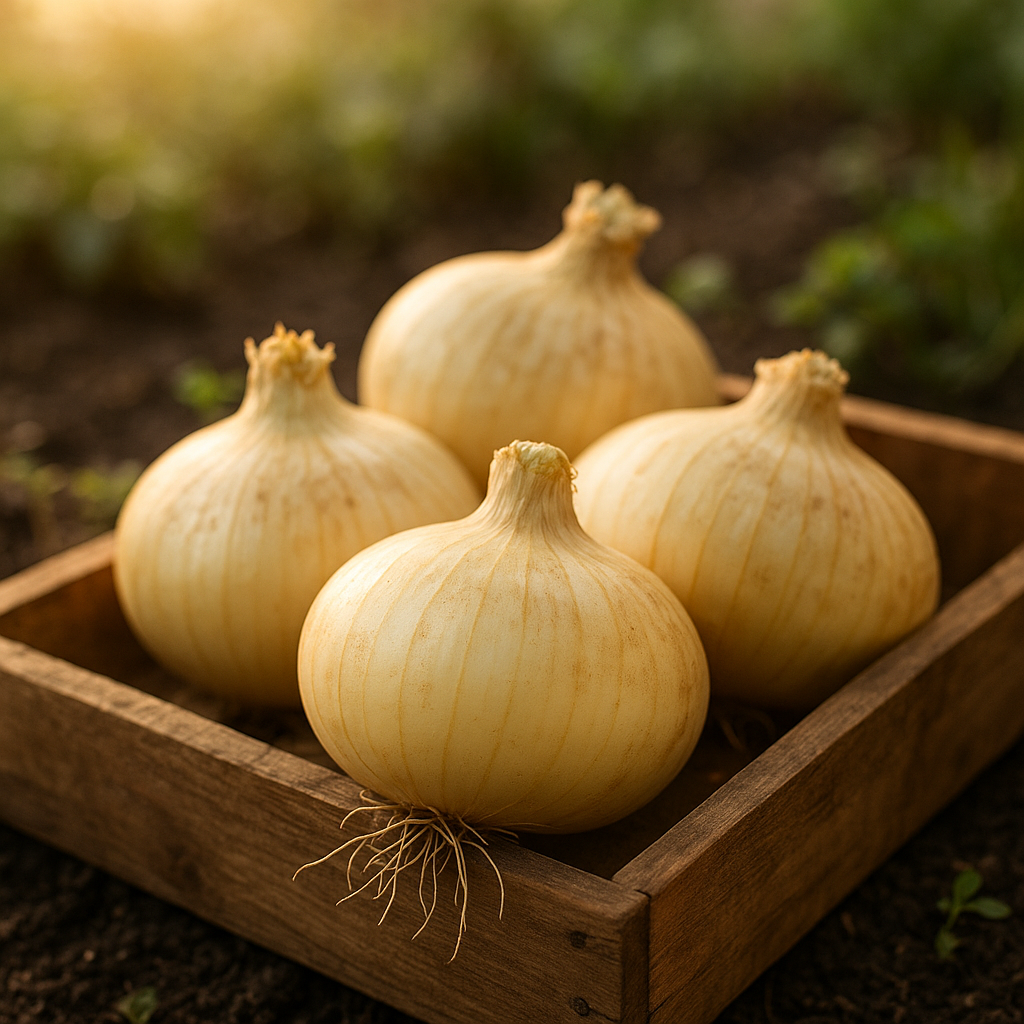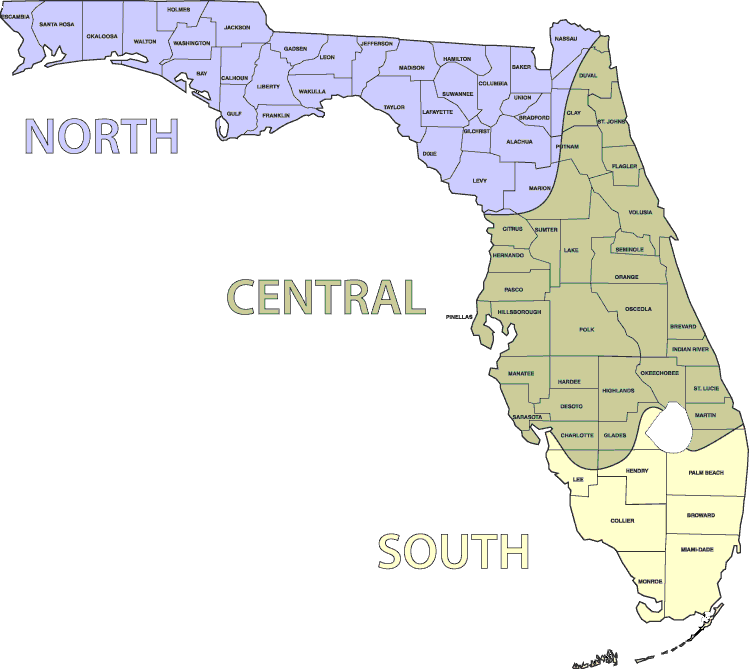Onion Varieties for Florida
Onions, with their crisp, flavorful bulbs and tall, slender green tops, add a practical and aromatic touch to any garden. Known for their versatility in the kitchen, onions come in a variety of types, including red, yellow, and white, each with its unique flavor profile. Their growth begins with small, green shoots that develop into robust, layered bulbs, making onions a staple in garden beds or containers.
In Florida planting zone 9, onions grow well, particularly during the cooler months. The plants form into sturdy bulbs beneath the soil while their tops reach skyward. Watching the bulbs swell and mature underground is a satisfying experience, signaling the success of your gardening efforts.
For those new to gardening, onions are a rewarding choice. They are relatively easy to grow and provide a continuous supply of fresh bulbs that can be used in a wide range of dishes. Whether you enjoy them raw, sautéed, or caramelized, onions bring a flavorful and aromatic element to your meals, making your gardening endeavors both productive and delicious.
I would give onions a 4 out of 5 on how easy they are to grow. They are relatively straightforward to cultivate, making them suitable for both beginners and experienced gardeners.
Affiliate Disclaimer:
Ocala Food Forest participates in affiliate programs that help support our educational and community projects. When you purchase through the links provided on our site, we may receive a small commission at no additional cost to you. This support allows us to keep the site free to access and continue researching what grows best in Central Florida’s Zone 9 climate. We only recommend products and resources we have personally tested and trust.
Granex (Vidalia)
Hybrid

Description: Granex onions, commonly known as Vidalia onions when grown in specific regions of Georgia, are sweet onions with a mild flavor. They have a slightly flattened shape and a pale yellow skin.
Growing Season: Fall and Winter
USDA Planting Zone: 7-10
Special Notes: Excellent for fresh eating due to their mild flavor. Ideal for salads and sandwiches.
Texas Super Sweet
Hybrid

Description: Texas Super Sweet onions are large, globe-shaped onions with a very sweet flavor. They have a light yellow to white skin and are known for their excellent storage qualities.
Growing Season: Fall and Winter
USDA Planting Zone: 7-10
Special Notes: Suitable for fresh use and storage. They are one of the sweetest onion varieties available.
Red Creole
Heirloom

Description: Red Creole onions are small to medium-sized, globe-shaped onions with a deep red skin. They have a pungent flavor and are excellent for cooking and salads.
Growing Season: Fall and Winter
USDA Planting Zone: 7-10
Special Notes: Good storage qualities and can add color to dishes. They are heat-tolerant and perform well in warm climates.

Description: Yellow Granex onions are similar to the Granex (Vidalia) but are specifically bred to thrive in warmer climates. They have a sweet, mild flavor and are slightly flattened in shape.
Growing Season: Fall and Winter
USDA Planting Zone: 7–10
Special Notes: Ideal for fresh eating and cooking. They are not as pungent as other yellow onion varieties.
White Bermuda
Heirloom

Description: White Bermuda onions are large, flat onions with a mild, sweet flavor. They have white skin and are commonly used in salads, sandwiches, and cooking.
Growing Season: Fall and Winter
USDA Planting Zone: 7-10
Special Notes: They are excellent for fresh use and are relatively easy to grow. They mature quickly compared to other varieties.
Egyptian Walking Onion (Allium × proliferum)
Heirloom

Description: Egyptian Walking Onions, also known as Tree Onions or Topset Onions, are unique perennial onions that produce small clusters of bulbils at the top of their stalks instead of flowers. These bulbils can be planted to grow new onions, hence the name "walking onions," as they can spread and "walk" across the garden over time.
Growing Season: Fall, Winter, and Spring
USDA Planting Zone: 3-9
Special Notes: Flavor: The bulbs have a strong, pungent flavor similar to regular onions. The greens can be used like scallions, and the small top-set bulbs are great for pickling or fresh use. Growth Habit: The plant produces a main bulb underground, which can be harvested like a regular onion, and clusters of small bulbils at the top of the stalk. The stalks can fall over on the ground and the bulbils can root, creating new plants. Perennial: Yes, Egyptian Walking Onions are perennial and can be left in the ground year-round, producing new growth each season.
Florida Vegetable Planting Guide
This guide provides information on when to start seeds inside, direct seed, and transplant starter plants in the different regions of Florida.
North USDA Planting Zones: 8b-9a
Central USDA Planting Zones: 9b & some of 10a
South USDA Planting Zones: 10a-11b
Visit the U.S. National Arboretum for an Exact USDA Planting Zone Map.

| Bulb Onions | North Florida | Central Florida | South Florida |
|---|---|---|---|
| Start Seeds Inside | Sep-Nov | Oct | Oct |
| Direct Seed | Not recommended | Not recommended | Not recommended |
| Transplant Starter Plants | Mid Sep-Mid Nov | Oct | Oct |
| Bunching Onions | North Florida | Central Florida | South Florida |
|---|---|---|---|
| Start Seeds Inside | Jul-Feb | Jul-Feb | Aug-Feb |
| Direct Seed | Aug-Mar | Aug-Mar | Sep-Mar |
| Transplant Starter Plants | Sep-Mar | Sep-Mar | Oct-Mar |
Explanation:
Bulb Onions
Start Seeds Inside: Starting onion seeds indoors in the fall allows for controlled conditions, ensuring strong seedlings ready for transplanting outdoors in the winter.
Direct Seed: Direct seeding onions is not recommended because it can be challenging to achieve consistent germination and growth in outdoor conditions.
Transplant Starter Plants: Transplanting onion starter plants during the winter helps them establish quickly in the garden, leading to a productive harvest.
Bunching Onions
Start Seeds Inside: Starting bunching onion seeds indoors allows for controlled conditions and ensures strong seedlings ready for transplanting outdoors.
Direct Seed: Direct seeding bunching onions in the fall ensures rapid establishment and growth in cooler temperatures.
Transplant Starter Plants: Transplanting bunching onion starter plants during the cooler months helps them establish quickly and continue growing without the stress of high temperatures.
Depending on type, onions may be grown from seed, sets, transplants, or division. Bulb onions must be planted in fall. Green/bunching onions may be grown fall through spring. Plant close and harvest (thin) as needed. Insert sets upright for straight stems. Divide and reset multiplier types every year.
Soil: Onions prefer well-drained, fertile soil with a pH between 6.0 and 6.8. Amend the soil with compost or well-rotted manure to improve fertility and structure.
Sun: Full sun is essential for optimal growth. Ensure onions receive at least 6-8 hours of sunlight daily.
Watering: Keep the soil consistently moist but not waterlogged. Mulching helps retain soil moisture and regulate temperature.
Spacing: Plant bulb onion sets or transplants 4-6 inches apart in rows spaced 14 inches apart. Proper spacing ensures adequate air circulation and room for bulb development.
Plant bunching onion sets or transplants 2 -inches (green) 4-6 inches (shallots & leeks) apart in rows spaced 12-18 inches apart. Proper spacing ensures adequate air circulation and room for bulb development.
Fertilization:
N-P-K Ratio: Onions benefit from a balanced fertilizer with a slightly higher phosphorus content to support bulb development, such as 10-20-10 or 8-24-24.When to Add:
Before Planting: Apply the fertilizer to the soil before planting seeds or transplants to promote strong initial growth and root development.
Mid-Growing Season: Reapply the fertilizer about six weeks after planting to support continued growth and bulb development.
Application Tips:
Follow the directions on the fertilizer package to avoid over-fertilization.
Apply the fertilizer evenly around the base of the plants and water thoroughly to help the nutrients reach the roots.
Additional Tips:
Onions grow best in well-drained soil rich in organic matter, so consider adding compost to improve soil fertility and structure.
Mulch around the plants to help retain moisture, suppress weeds, and regulate soil temperature.
Ensure that onions receive consistent moisture, especially during bulb formation, to prevent stress and promote even growth.
Blog post on Natural Fertilizers
Harvest:
Bulb Onions (big and round): These are typically ready to harvest when the tops turn yellow and fall over, usually around 100-130 days after planting. Once the tops have fallen, gently pull the onions from the soil and let them cure in a warm, dry place for a few days before storing.Scallions/Green Onions (thin and long): These can be harvested much earlier, usually 50-100 days after planting, when they reach a usable size, about 6-8 inches tall. They can be pulled from the soil and used fresh without curing.
By selecting the right onion varieties and following these growing tips, you can achieve a successful and bountiful onion harvest in your Florida garden.
Pests and Diseases that affect Onions in Florida:
Onion Maggots: Larvae that feed on the roots, causing the plant to wilt and die.
Thrips: Small insects that feed on the leaves, causing silvery streaks and reducing plant vigor.
Aphids: Small insects that suck sap from the leaves and stems, causing curling and yellowing.
Natural Pest Control
Downy Mildew: A fungal disease that causes yellowing leaves with a fuzzy, grayish growth on the underside.
White Rot: A fungal disease that causes a white, fluffy growth on the roots and bulbs, leading to decay.
Botrytis Leaf Blight: A fungal disease that causes grayish-brown spots on the leaves.
Companion Plants
Description: Carrots are root vegetables known for their sweet flavor and crunchy texture.
Growing Season: Fall and spring
USDA Planting Zone: 2-10
Special Notes: Carrots prefer loose, well-drained soil.
How it Helps: Carrots can help break up soil, improving aeration and drainage for onions. They also benefit from the pest-repelling properties of onions.
Description: Lettuce is a leafy green vegetable known for its crisp texture and mild flavor.
Growing Season: Fall to spring
USDA Planting Zone: 2-10
Special Notes: Lettuce prefers full sun to partial shade and well-drained soil.
How it Helps: Lettuce can help shade the soil, keeping it cool and reducing weed growth around onions. It also does not compete heavily for nutrients with onions.
Description: Marigolds are bright, sunny flowers that come in a variety of colors including yellow, orange, and red.
Growing Season: Spring through fall
USDA Planting Zone: 2-11
Special Notes: Marigolds release chemicals in the soil that deter nematodes and other soil-borne pests.
How it Helps: Marigolds help repel nematodes, aphids, and other pests. Their roots release a substance that helps prevent nematodes, protecting onion roots.
Description: Beets are root vegetables known for their sweet, earthy flavor and vibrant red color.
Growing Season: Fall and spring
USDA Planting Zone: 2-10
Special Notes: Beets prefer full sun and well-drained soil.
How it Helps: Beets can help improve soil structure and nutrient availability for onions. They also benefit from the pest-repelling properties of onions.
Description: Chamomile is a daisy-like herb known for its small, white flowers and calming properties.
Growing Season: Spring to summer
USDA Planting Zone: 3-9
Special Notes: Prefers full sun to partial shade and well-drained soil.
How it Helps: Chamomile attracts beneficial insects like hoverflies and parasitic wasps that prey on aphids and other pests. It also has antifungal properties that can help protect onions from diseases such as downy mildew.
These companion plants help protect onions from pests and diseases while also enhancing the overall health and productivity of the garden.
For onions, here are the vegetable plants that should not be planted nearby:
Garden Beans - Onions can inhibit the growth of beans.
Peas - Similar to beans, onions can stunt the growth of peas.
Sage - Competes for nutrients and can negatively affect onion growth.
Asparagus - Onions can negatively affect the growth of asparagus.
